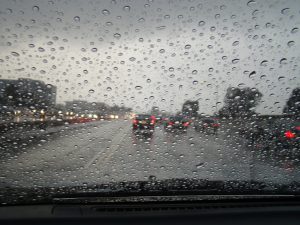
Locally, we are expected to get an inch of rain. What does this mean for drivers?
With heavy rainfall and the ground is already saturated, we could expect some flooding. We are also expecting to have strong wind gusts. While driving, watch for debris to blow across the road, down power lines and trees.
Flooding can cause major issues when driving out on the road. If you are driving during heavy rain, here are a few things to keep in mind.
1. Slow Down
The most important thing you can do to stay safe in inclement weather is to slow down. Rainy conditions create slick roads, which increases the amount of time it takes your vehicle to come to a complete stop. You should give yourself more following distance than the usual 6-8 seconds and adjust your speed so that you will have plenty of time to stop at traffic lights.
2. Turn Your Headlights On
Anytime your wipers are on, your headlights have to be on. It’s the law. Rain makes it harder for other drivers to see your vehicle.
3. Avoid Hydroplaning
Hydroplaning is most common during the first few minutes of rainfall as the roads develop a slick layer of water and oil. If you wait a while before heading out, the rain will wash away the oil and other substances that got stirred up and the roads will become safer to drive on. However, you can still hydroplane if you’re driving too fast or you hit standing water. If you start hydroplaning, let off the gas and gently steer in the direction you want to go. Avoid jerking the steering wheel or hitting the brakes as these can cause you to lose control of the vehicle.
4. Don’t Driving Through Standing Water
It only takes a couple of inches of standing water to make your car lose control. Driving through standing water can not only cause you to hydroplane, but it can also cause damage to the engine and electrical components if water gets pushed up into your engine. Since it’s difficult to tell how deep standing water on the road is, TURN AROUND, DON’T DROWN!
5. When In Doubt, Don’t Go Out
Sometimes it rains so heavily that you can’t see clearly and/or you can’t handle your vehicle safety, we suggest you pull over to a safe spot and wait for the worst of the storm to pass, or if you’re driving on the highway, take an exit and wait. Never drive through flood waters and never drive in conditions you don’t feel safe in.
Many drivers, unfortunately, underestimate the dangers of driving in rain, which lead to thousands of crashes every year
